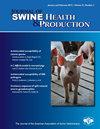猪临床试验研究中的价值最大化和浪费最小化:设计特征以减少偏倚
IF 0.7
4区 农林科学
Q3 Agricultural and Biological Sciences
引用次数: 1
摘要
研究人员设计试验时应采用旨在减少偏倚的设计特征。这些措施包括随机分配到干预组和对护理人员和结果评估人员进行盲法。应报告产生随机序列的方法,以及如果使用分层或阻断的方法。当不可能采用盲法时,应使用客观测量的结果。当所有符合条件的猪圈或动物都被登记,并且没有干预组的偏好时,分配隐藏可能不是必要的。应公开提供先验试验方案,并报告所有评估结果的结果。本文章由计算机程序翻译,如有差异,请以英文原文为准。
Maximizing value and minimizing waste in clinical trial research in swine: Design features to minimize bias
Researchers designing trials should implement design features intended to reduce bias. These include random allocation to intervention groups and blinding of caregivers and outcome assessors. The method of generating the random sequence should be reported, as well as methods for stratification or blocking if used. When blinding is not possible, objectively measured outcomes should be used. Allocation concealment may not be essential when all eligible pens or animals are enrolled and there is no preference for intervention group. An a priori trial protocol should be made publicly available, and results for all outcomes evaluated should be reported.
求助全文
通过发布文献求助,成功后即可免费获取论文全文。
去求助
来源期刊
CiteScore
1.80
自引率
0.00%
发文量
29
审稿时长
>36 weeks
期刊介绍:
The Journal of Swine Health & Production (JSHAP) is an open-access and peer-reviewed journal published by the American Association of Swine Veterinarians (AASV) since 1993. The aim of the journal is the timely publication of peer-reviewed papers with a scope that encompasses the many domains of applied swine health and production, including the diagnosis, treatment, management, prevention and eradication of swine diseases, welfare & behavior, nutrition, public health, epidemiology, food safety, biosecurity, pharmaceuticals, antimicrobial use and resistance, reproduction, growth, systems flow, economics, and facility design. The journal provides a platform for researchers, veterinary practitioners, academics, and students to share their work with an international audience. The journal publishes information that contains an applied and practical focus and presents scientific information that is accessible to the busy veterinary practitioner as well as to the research and academic community. Hence, manuscripts with an applied focus are considered for publication, and the journal publishes original research, brief communications, case reports/series, literature reviews, commentaries, diagnostic notes, production tools, and practice tips. All manuscripts submitted to the Journal of Swine Health & Production are peer-reviewed.

 求助内容:
求助内容: 应助结果提醒方式:
应助结果提醒方式:


